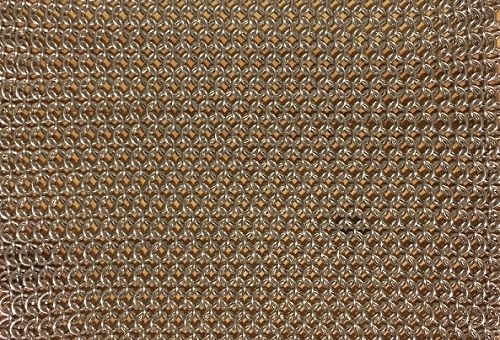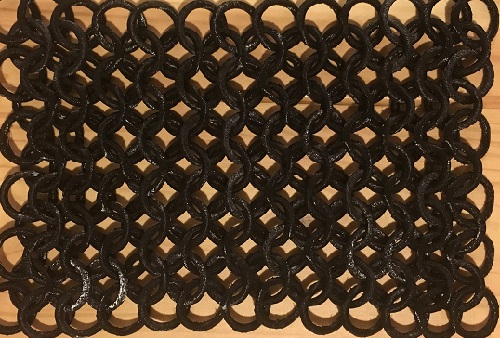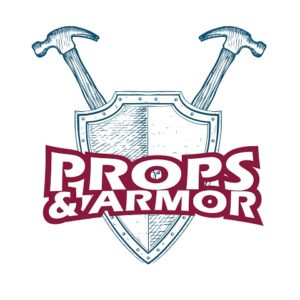Chainmail, or mail armor, is a type of armor that has been in use for thousands of years, across many different parts of the world. Because of how commonly it was used in the medieval ages and even into the Renaissance, it is impossible to imagine a fantasy setting that doesn’t include some form of chainmail armor. For these reasons, there are many armors from movies and video games that utilize chainmail in their design.
Historically, chainmail armor was made of interwoven steel rings, as you probably know. To keep the rings from coming apart, each ring was riveted shut. Sometimes solid rings were also used, but almost all chainmail armor was made with riveted steel rings. There was such a thing as butted mail, which was not riveted and was therefore much weaker, but it was far less common for that reason.
You’ve probably realized that historically accurate riveted steel mail is impractical for use in a costume. For one thing, a full mail shirt can weigh over 40 pounds, which is way too cumbersome to wear at a convention for hours on end. Secondly, it would reportedly take a whole season for a workshop of armorers working full time to assemble one mail shirt. One person working part time, like a lot of cosplayers, would probably need at least a year to make one.
Luckily, there are some lightweight, cheaper, and easier to make options for those who want something that looks similar to real chainmail. Some of these are more believable than others, so you’ll have to decide which one works best for your particular costume.
1. Chainmail Fabric Print
One option is to use fabric with a chainmail pattern printed onto it. If you look online you’ll find some options for fabric that you can buy by-the-yard with a chainmail pattern printed onto the surface, or sometimes you can find ready-made garments with similar patterns.
This a great option because it’s super lightweight, flexible, and breathable, if you can get it in the right kind of fabric. Cotton is a good option for its breathability. In any case, it will weigh next to nothing compared to steel chainmail.
A lot of the fabrics I found used butted mail for the design, which may or may not be good enough for your costume. From a distance it’s hard to tell the difference between butted and riveted mail, so it might not be a deal breaker for you.
If you really want printed chainmail clothing with a realistic, riveted mail design, then you might want to check out this YouTube video by Shadiversity. He designed his own pattern and there are links in the description of his video to clothing that you can buy with that pattern.
If you use this kind of fabric to cover large areas of your costume, be aware that it will probably show some wrinkles and creases just like any other fabric. This will make it less realistic and much less believable, even from a distance. For this reason I think that it would work best for covering small areas or in between other pieces of armor or costume. Places like the inner elbows, armpits, or around the hips might work well.
2. Aluminum Chainmail

Another option that I see a lot of people use is aluminum chainmail. This is a great option because it’s probably the closest thing on this list to real chainmail. Instead of steel rings it uses aluminum rings, which makes it much lighter.
Most aluminum chainmail that you can buy online will be butted mail, but you can also find riveted aluminum mail. If you plan on wearing it often, then riveted mail is probably better because the rings are much less likely to come apart. With butted mail, the rings can open up over time, especially with softer aluminum rings. If you only plan on wearing the chainmail for a few hours at a time and you won’t be doing much physical activity, then butted mail is probably good enough.
Aluminum chainmail is very often lighter in color and shinier than steel chainmail, which can make it look a bit less authentic. If the chainmail in your costume is supposed to look bright and shiny then this is a good thing, but if you’re going for a darker, dingier appearance, then the bare aluminum might be too bright.
To counteract this you can simply use some dark spray paint and lightly mist it onto the chainmail. You can even use a bit of brown or red paint to make it look a bit rusty. You could also apply the paint by hand, which might give you a bit more control.
If you have enough time and you’re feeling up to it, you could even make your own aluminum chainmail. That way you can choose the exact kind of rings you want to use for your costume. Rings come in different thicknesses of wire, different diameters, and even different polishes. Some rings are shinier and more polished, while others are more dull. You can even buy anodized aluminum rings in many different colors. If the ready made aluminum chainmail doesn’t match what you’re looking for, then making it yourself might be a good option.
This is just a thought, but I think that polished aluminum rings could be a very good way to make mithril mail. The brightness and light, almost whitish color actually works very well if that’s the kind of costume chainmail you want to make.
3. 3D Printed Chainmail

If you don’t want to spend money on already made chainmail and you happen to have a 3D printer, then you can just the let machine make it for you. There are many different 3D files online that you can find for chainmail sheets, but I’ll link to one of them here that I’ve used. Basically it prints the rings so that they all interconnect, so when it’s done you just peel it off of the print bed and it’s fully assembled.
The 3D printer can’t do all the work though, because you’ll still need to assemble the various sheets together to make your finished piece. To do this you can print open rings and weave them into the chainmail, then melt them closed with a soldering iron or other hot tool. You’ll need to do this a lot, especially if you plan on making a large garment of chainmail, so make sure to be in a well ventilated area in case of any smoke from melting the rings closed.
You can also adjust the scale to make the rings as big or small as you need them to be. Just make sure to use the same scale setting every time you print a sheet.
Because they’re 3D printed, you can choose what color of filament to use for them. I just used black PLA filament for mine and I plan to add some metallic paint later, but there are metallic filaments available that might work very well for this. These have metallic powder infused in the PLA, so they can be a bit tricky to print with.
The metallic powder in the filament can cause a lot of wear on normal print heads, so you might need to invest in a more durable print head, or be ready to switch yours out as soon as it starts to wear out.
4. PVC Chainmail
One method of making costume chainmail that I learned about by watching behind-the-scenes videos of movies is by using PVC pipes, or other plastic pipes. If you get a small pipe with the internal diameter that you want for your rings, and the wall thickness that is not too thick, then you can just slice the pipe into a bunch of little plastic rings.
Once you have the rings cut out of the pipe, you can make a cut into each one so that you can weave them together. Or you can leave some solid and weave those in with the cut rings, either way works fine.
This method will result in rings that look flattened instead of round, which is good for some costumes, but might be wrong for others. Flattened rings were used historically because they cover more surface area and protect better against stabbing attacks than round rings. If you can’t tell from any reference images whether your costume is supposed to have flat or round rings, then I think it would be fine to use flat rings.
If you start with a grey colored plastic pipe then it will already look slightly metallic as soon as you finish weaving the rings together, but it would probably look better after some paint. Like I said earlier, you can use spray paint or hand brush the paint on, which ever works better for you.
5. Knitted Chainmail
This is probably one of the least authentic options on this list, but also one of the most lightweight, so it might be right for some people. Knitted chainmail is yarn that has been knitted into a pattern that somewhat resembles chainmail. It has been used in theater and movies for many years, probably because it is so comfortable and cheap to produce.
Another benefit of knitted chainmail is that it can fit comfortably under any other armor or costume pieces that you might be wearing. If you tried to use a harder type of chainmail it might get uncomfortable, but knitted chainmail will probably be just fine.
From a distance it does kind of look like chainmail, although it’s clearly not shiny or metallic at all. The way it stretches is also not at all like chainmail. I think that if you used it sparingly it could work well. You could also apply some metallic paint to it to make a bit more realistic.
6. Foam Chainmail
EVA foam is often the material of choice for costumes because of its light weight and ease of crafting. It turns out that it’s also good for making lightweight chainmail. There are a few different methods for making chainmail with EVA foam, so I’ll go over all that I could find.
The first method would be to cut out individual rings from thin EVA foam, probably around 2 or 3 millimeters thick. Then you could cut some of them open so that you could weave them together, and then glue them shut. You could use rubber cement, but that would probably take a lot longer than if you just super glued the ends together.
The final product would be a lightweight chainmail that moves and articulates just like the real thing, but without all the weight. It won’t have the same jingle that metal or plastic chainmail has, but the extra weight savings might make it worth it.
The other method of making foam chainmail is a lot faster, but only if you have access to a laser cutter, or some other kind of CNC cutting machine. If you don’t have a laser cutter and don’t want to buy one, then check your local maker space and see if they have one that you can use. Often times they’ll just have you take a quick instructional and safety course before they let you use it.
This method involves laser cutting out wavy strips of EVA foam, and then weaving them together. The result is a sheet of foam that is kind of knitted together and closely resembles a chainmail pattern. I found out about this method from a guy on YouTube named Ben Eadie, who came up with the idea. Here’s a link to his video, and in the description he has a link to the object files so that you can make it yourself.
I think that his method is really smart and it’s a very fast way to make something that looks like chainmail, but it doesn’t move quite like real chainmail because it’s not made of individual rings. Still, if you have access to laser cutter and are fine with the lack of articulation, then this could be a good option for you.
7. Mesh
From a distance, chainmail kind of looks like a sort of mesh, so why not just use mesh to begin with? It’s cheap, lightweight, and you don’t have to assemble anything. As for what kind of mesh to use, I think that either fabric or foam mesh would work best for this.
If you use fabric mesh, try to find one that has a circular pattern to the holes, so that it sort of resembles the rings of chainmail. I think that if you got a black, grey, or white fabric mesh and then added some metallic paint, it could make a pretty good costume chainmail.
There’s also foam mesh, but it can be a bit tricky to search for it online. If you just search for foam mesh, then you can get all kinds of things. One kind of foam mesh that I’ve seen used before is actually sold as a shelf liner, and you can find it in a lot of stores that sell home goods. You can also find it online if you search for something like “foam mesh shelf liner.”
Here’s a link to what I’m talking about on Amazon, but there are many different brands and variations that you might be able to find in other places.
This kind of foam mesh is thin, lightweight, and very flexible, so it kind of replicates the flexibility of chainmail. Like the fabric mesh, I think that if you just apply some metallic paint, it can be a good alternative. If you can get it in a dark color like black or grey, that would probably be easier than starting with white, but either way could work.
Conclusion
I hope that this article gave you a lot of ideas or options to choose from to make your costume with chainmail. It doesn’t need to be difficult or time consuming to have a believable effect. Good luck with your costumes!
